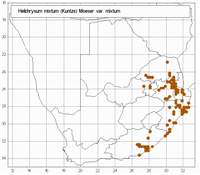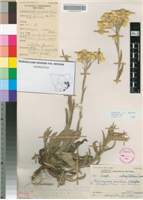Origin of name:
mixtus/ -a/ -us = mixed
Diagnostic characters:
Large headsBright yellow bractsOpen branched inflorescence
Description:
Perennial herb, stock stout, woody, flowering stems several from the crown, simple, erect to c. 450 mm, thinly greyish-felted, leafy throughout. Radical leaves rosetted, c. 40�100 (�190) x 10�20 (�40) mm, elliptic, elliptic-lanceolate or oblanceolate, apex acute or subacute, slightly narrowed to a broad clasping base, both surfaces thinly grey-woolly; cauline leaves much smaller, diminishing in size upwards, lanceolate to linear-lanceolate, acute to acuminate, base broad, clasping, shortly decurrent, both surfaces thinly grey-woolly. Heads homogamous, campanulate, 6.5�9 mm long, several in a congested or open corymbose panicle. Involucral bracts in c. 6�8 series, subequal or slightly graded, loosely imbricate, inner slightly exceeding flowers, radiating, glossy, bright yellow, all acute or subacute or sometimes inner obtuse. Receptacle with fimbrils exceeding ovaries. Flowers 48�132, yellow. Achenes 1 mm long, barrel-shaped, glabrous. Pappus bristles many, scabrid, tips barbellate, bases cohering strongly by patent cilia.
Flowering mainly between November and January in the Cape and Natal, but mostly later in Mpumalanga, principally March and April.
Distribution:
Grows in grassland. Widely distributed from the E. highlands of Zimbabwe to the high parts of the Mpumalanga and Swaziland, through the eastern half of KwaZulu-Natal to the E. Cape as far west as East London, the Amatola Mountains and the mountains about Queenstown.
Grassland, Savanna and Thicket Biomes.
Notes:
H. mixtum is aptly named, for it combines the foliage of H. cephaloideum with the loose inflorescence and acute involucral bracts of H. longifolium, as Kuntze himself pointed out, and it is not always possible to place specimens with certainty. In the Cape, despite the inner involucral bracts often being as obtuse as in H. cephaloideum, there is no difficulty in distinguishing H. mixtum with heads consistently larger than those of H. cephaloideum and loosely arranged. In KwaZulu-Natal and Mpumalanga, however, the situation is not so clear cut. In KwaZulu-Natal, it is often difficult to decide whether a specimen is better placed as H. mixtum or H. cephaloideum or even H. longifolium. As suggested before (Hilliard l.c.), this may be due to crossing, or speciation in this whole difficult group may be incomplete. In Mpumalanga, the situation is complicated by the presence of a plant that differs from H. mixtum in its larger heads with less glossy involucral bracts, and in its earlier flowering time. For convenience, it is accorded varietal rank, but experimental work on the whole group is highly desirable.Taxonomy:
Literature:
Helichrysum mixtum (O. Kuntze) Moeser in Bot. Jb. 44: 320 (1910); Hilliard, Compositae in Natal 185 (1977).
Type:
Cape, Cathcart, O. Kuntze (NY, holo.; K, photo.; Z, iso.).
Synonym(s):
Gnaphalium mixtum O. Kuntze, Rev. Gen. Pl. 3,2: 152 (1898).
Vouchers:
Compton 25453 (PRE); Devenish 1624 (E; K; NU); Galpin 6295 (PRE); Hilliard & Burtt 10980 (E; K; MO; NU; PRE; S); Story 3323 (PRE).

_sml.jpg)
_sml.jpg)
_sml.jpg)
_sml.jpg)
